Viola cucullata Aiton
Common names:
Blue Marsh Violet
Synonyms:
Viola cucullata Aiton, Hort. kew., ed. 1, 3: 288. 1789; V. palmata L. var. cucullata (Aiton) A.Gray, Bot. Gaz. 11: 254. 1886. TYPE: "Hort. Kew 1778" (HOLOTYPE: BM001134389!, JSTOR Global Plants image!, MICH-photo).
Viola cucullata Aiton f. prionosepala (Greene) Brainerd, Rhodora 15: 112. 1913; Viola prionosepala Greene, Pittonia 5: 99. 1902
Viola cucullata Aiton var. microtitis Brainerd, Rhodora 15: 112. 1913
Viola planifolia Greene, Leafl. bot. observ. 2(2): 41. 1910-1912
Viola cucullata Aiton var. leptosepala (Greene) W.Stone, Proc. Acad. Nat. Sci. Philadelphia 1903: 674. 1903; Viola leptosepala Greene, Pittonia 5: 98. 1902
Viola macrotis Greene, Pittonia 5: 97. 1902
Viola consors Greene, Pittonia 5: 100. 1902
Viola watsonii Greene, Pittonia 4: 5. 1899
Viola cucullata Aiton f. albiflora Britton, Bull. Torrey Bot. Club 17: 124. 1890
Viola obliqua Aiton, Hort. kew., ed. 1, 3: 288. 1789
Description:
Acaulescent rosulate perennials from thick rhizome, ≤ 26 cm tall; foliage and peduncles light to medium green, glabrous or upper surface of leaf blades with small scattered subappressed hairs; stipules free, irregularly glandular-fimbriate; leaves ascending, leaf blades undivided, largest ≤ 100 × 64 mm, narrowly ovate to broadly ovate, base cordate, margins crenate-serrate with apical teeth remote and shallow, eciliate, apex acute to narrowly obtuse; chasmogamous peduncle held well above the leaves; chasmogamous flower ≤ 23 mm; calyx glabrous, eciliate (frequently sparsely ciliate in ne. boreal populations); lowest sepals linear-lanceolate to lanceolate, acuminate; auricles prominent, entire or erose, elongating to 7 mm in fruit (auricles scarcely elongate in ne. boreal populations); corolla pale violet with heavy dark purple eyespot around throat, throat white; spur short-globose; lateral petals densely bearded with short clavate to reniform hairs, spurred petal glabrous; cleistogamous flowers produced after chasmogamous, on erect peduncle slightly shorter to longer than petioles; capsule 10–15 mm, green drying tan, unspotted, glabrous; seeds 1.4–1.9 × 0.8–1.3 mm, dark brown to dark reddish-brown, unspotted; 2n=54.
Similar species:
In chasmogamous flower, only Viola communis f. priceana could be mistaken for this species, since both produce pale corollas with a conspicuously contrasting dark eyespot around the throat, and have a glabrous spurred petal and prominent auricles; Viola cucullata differs from V. communis f. priceana in having flowers strongly overtopping the leaves, linear to linear-lanceolate sepals acuminate from the base, and short lateral petal beards with strongly clavate to doorknob-shaped hairs that do not obscure the throat of the corolla. In cleistogamous fruit this species is distinct from several other glabrous uncut-leaved taxa, such as V. affinis, V. impostor, V. latiuscula, V. missouriensis and V. sororia in producing unspotted cleistogamous capsules on tall erect peduncles. Among taxa with unspotted capsules on ascending to erect peduncles, it differs from V. communis, V. domestica, V. impostor, V. pratincola and V. retusa in the taller peduncles reaching or exceeding the petioles, longer auricles, and unspotted dark brown to reddish-brown seeds.
Ecology:
Circumneutral to acidic saturated sandy, peaty or mucky soils in seeps, springs, marshes, swamps, bog forests, and wet borders of streams, rivers, and lakes.
Distribution:
Widely distributed across eastern North America, NL to nw. ON, south to GA, MS and MO.
Rarity:
None.
Phenology:
Chasmogamous flower April–July, chasmogamous fruit June–July, cleistogamous fruit July–August.
Affinities:
This species belongs to the Acaulescent Blue Violet lineage, sect. Nosphinium W.Becker, subsect. Boreali-Americanae (W.Becker) Gil-ad, in the Cucullata species group.
Hybrids:
Hybridizes with V. affinis (Brainerd 1906b, 1924, House 1924, Gaiser and Moore 1966, Haines et al. 2011), V. brittoniana (Bicknell 1904, House 1905, Brainerd 1906b, 1907a, 1924, Haines et al. 2011), V. communis [or possibly V. "sororia glabrous" or V. "sororia hirsutula-like"] (Brainerd 1906b, 1924, House 1924), V. fimbriatula (Pollard 1897, Brainerd 1904b, 1905, 1924, House 1924, Henry 1953a, Haines et al. 2011), V. nephrophylla (Brainerd 1906b, 1924, House 1924, Haines et al. 2011), V. palmata var. triloba (Brainerd 1906b, 1913c, 1924, House 1924, Haines et al. 2011), V. pectinata (Brainerd 1924), V. primulifolia (Bicknell 1904, Brainerd 1906b, 1909, 1924, House 1924), V. sagittata (Brainerd 1906b, 1924, House 1924), V. septentrionalis (Brainerd 1904b, 1924, House 1924), V. sororia sensu stricto (Brainerd 1904b, 1924, House 1924, Henry 1953a, Haines et al. 2011), V. subsinuata sensu stricto (Brainerd 1913c, 1924, House 1924, Haines et al. 2011), and V. viarum (Brainerd 1924). Brainerd reported that the hybrids involving only acaulescent blue violet taxa express intermediate or recombinant traits in foliage, chasmogamous flowers, cleistogamous capsules and seeds (when these do not abort). All hybrids fail to reproduce by chasmogamous flowers, and the cleistogamous capsules are abortive or produce extremely few viable seeds. The situation surrounding V. ×lavandulacea E.P.Bicknell is interesting. Bicknell (1904) published it as a species. Brainerd (1906b) shortly thereafter interpreted its characters to indicate a hybrid of V. cucullata with V. emarginata sensu stricto, resisting Bicknell's insistence that V. primulifolia in the vicinity could be the other parent. In 1909, Brainerd rethought his position, inspired in that year by Forbes's discovery of a remarkable hybrid between V. brittoniana and V. lanceolata. Brainerd's later enumeration of intermediate features supported V. primulifolia as the second parent. House (1924) mentioned the hybrid and its taxonomic history, remarking that Brainerd's original assessment of V. emarginata as the second parent seemed more likely. My examination of the holotype image reveals very short auricles and rather short merely acute sepals that would be unlikely on a hybrid involving V. cucullata and V. emarginata sensu stricto, two species with very prominent auricles and long-acuminate sepals in chasmogamous flower. Examination of pollen fertility and morphology of the style would provide convincing evidence; the pollen stainability of acaulescent blue hybrids is generally 50% to 90%, whereas a hybrid involving two very different ploidy levels would presumably have essentially 100% abortive pollen, and members of the Boreali-Americanae and Stolonosae groups have noticeably different style morphologies.
Comments:
Brainerd (1921), Brainerd Baird (1942), Fernald (1950), Henry (1953a), Alexander (1963), Russell (1965), Scoggan (1978), Strausbaugh and Core (1978), Swink and Wilhelm (1979), Gleason and Cronquist (1991), McKinney (1992), Ballard (1995, 2000, 2013), Gil-ad (1995, 1997, 1998), McKinney and Russell (2002), Haines et al. (2011), Voss and Reznicek (2012), Weakley et al. (2012), and Little and McKinney 2015) have recognized this distinctive taxon at species rank. Strausbaugh and Core referred Tosh's (1942) report and a second unidentified 1945 report of V. missouriensis from West Virginia to this species. While many other Acaulescent Blue species have long hairs in the lateral petal beards that are often weakly clavate, the very short beard hairs in this species are strongly clavate to reniform ("doorknob-shaped") and expose the interior of the throat in life. Populations from the boreal region of extreme ne. North America, from Maine eastward into maritime Canada, possess shorter sepals and short auricles that scarcely elongate or don't at all in fruit. Authors from Brainerd (1921) through Scoggan (1978), but excepting Russell (1965), segregated these northern variants as var. microtitis Brainerd, but they do not differ in any other observable respect from typical V. cucullata further south and are no longer formally recognized. Occasional plants with pubescent foliage and/or a sparsely ciliate calyx are invariably found in the vicinity of Viola septentrionalis or Viola sororia and are de novo hybrids. Most of the specimens previously identified as V. cucullata from the southestern Lower Atlantic Coastal Plain are the newly detected V. impostor, presented elsewhere in this treatment.
Literature Cited:
Alexander, E. J. 1963. Violaceae. In Gleason, H. A., The new Britton and Brown illustrated flora of the northeastern United States and adjacent Canada. Hafner Publishing Co., Inc., New York, NY. 552-567.
Bicknell, E. P. 1904. Three new violets from Long Island. Torreya 4: 129-132.
Brainerd, E. 1904b. Notes on New England violets. Rhodora 6: 8–17.
Brainerd, E. 1905. Notes on New England violets,-II. Rhodora 7: 1–8, Plate 50.
Brainerd, E. 1906b. Hybridism in the genus Viola,-II. Rhodora 8: 6–10.
Brainerd, E. 1907a. Mendel’s law of dominance in the hybrids of Viola. Rhodora 9: 211–216.
Brainerd, E. 1909. Another hybrid between a white and a blue violet. Rhodora 11: 115-116.
Brainerd, E. 1913c. Notes on new or rare violets of northeastern America. Rhodora 15: 112–115.
Brainerd, E. 1921b. Violets of North America. Vermont Agricultural Experiment Station Bulletin 224: 1–172.
Brainerd, E. 1924. The natural violet hybrids of North America. Vermont Agricultural Experiment Station Bulletin 239: 1-205.
Brainerd Baird, V. 1942. Wild violets of North America. University of California Press, Berkeley, CA.
Fernald, M. L. 1950. Violaceae. In Gray’s Manual of Botany, 8th ed. American Book Company, New York, NY. 1022-1042.
Forbes, F. F. 1909. A new hybrid violet. Rhodora 11: 14-15.
Gaiser, L. O. , and R. J. Moore. 1966. A survey of the vascular plants of Lambton County, Ontario. Plant Res. Inst. Can. Dept. Agric. Ottawa, Ont. 122 pp.
Gil-ad, N. L. 1995. Systematics and evolution of Viola L. subsection Boreali-Americanae (W. Becker) Brizicky. Ph.D. dissertation. University of Michigan, Ann Arbor, MI.
Gil-ad, N. L. 1997. Systematics of Viola subsection Boreali-Americanae. Boissiera 53: 1–130.
Gil-ad, N. L. 1998. The micromorphologies of seed coats and petal trichomes of the taxa of Viola subsect. Boreali-Americanae (Violaceae) and their utility in discerning orthospecies from hybrids. Brittonia 50: 91–121.
Gleason, H. A., and A. Cronquist. 1991. Violaceae. In Manual of vascular plants of northeastern United States and adjacent Canada, 2nd ed. New York Botanical Garden, Bronx, NY. 157-163.
Haines, A., E. Farnsworth, and G. Morrison. 2011. Violaceae. In Flora Novae Angliae. Yale University Press, New Haven, CT. 873-886.
Henry, L. K. 1953a. The Violaceae in western Pennsylvania. Castanea 18(2): 37-59.
House, H. D. 1905. Notes on New Jersey violets. Bulletin of the Torrey Botanical Club 32: 253-260, plates 16-18.
House, H. D. 1924. Annotated list of the ferns and flowering plants of New York state. Family 83 Violaceae. New York State Museum Bulletin 254: 499-512.
Little, R. J., and L. E. McKinney. 2015. Violaceae. In Flora of North America: Cucurbitaceae to Droseraceae, 106. Oxford University Press, New York, NY.
McKinney, L. E. 1992. A taxonomic revision of the acaulescent blue violets (Viola) of North America. Sida, Botanical Miscellany 7: 1–60.
McKinney, L. E., and N. H. Russell. 2002. Violaceae of the southeastern United States. Castanea 67: 369-379.
Pollard, C. L. 1897. Two new violets. Bulletin of the Torrey Botanical Club 24: 404-405, plate 314.
Russell, N. H. 1965. Violets (Viola) of the central and eastern United States: An introductory survey. Sida 2: 1–113.
Scoggan, H. J. 1978. Violaceae. In Flora of Canada, Part 3–Dicotyledoneae (Saururaceae to Violaceae). National Museums of Canada. Ottawa, Canada. 1103-1115.
Strausbaugh, P. D., and E. L. Core. 1978. Violaceae. In Flora of West Virginia, 2nd ed. Seneca Books, Inc., Morgantown, WV. 644-658.
Swink, F., and G. Wilhelm. 1979. Violaceae. In Plants of the Chicago region, 2nd ed. revised and expanded. Morton Arboretum, Lisle, IL. 384, 801-810.
Tosh, J. F. 1942. The vascular plants of Raleigh County, West Virginia. Castanea 7(4/5): 55-70.
Voss, E. G., and A. A. Reznicek. 2012. Violaceae. In Field manual of Michigan flora. The University of Michigan Press, Ann Arbor, MI. 913-922.
Weakley, A. S., J. C. Ludwig, and J. F. Townsend. 2012. Violaceae. In Flora of Virginia. BRIT Press, Fort Worth, TX. 963-975.
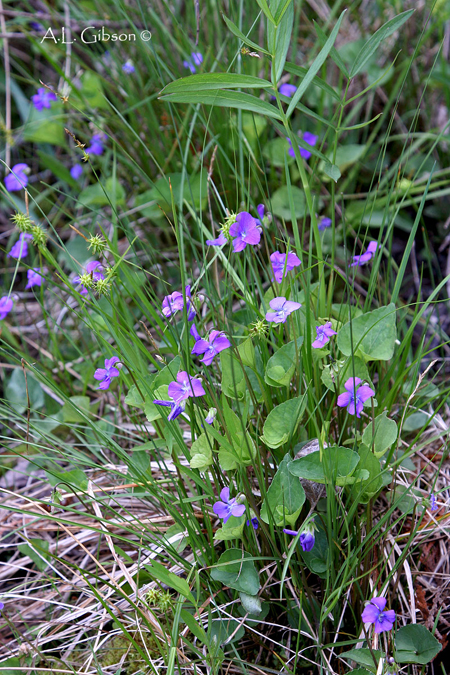
Chasmogamous flowering habit by Andrew Gibson, "Buckeye Botanist" website
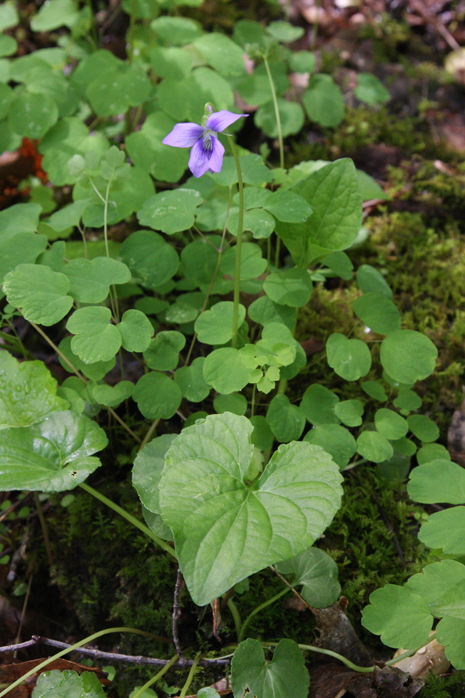
Leaves during chasmogamous flower by Bruce Sorrie
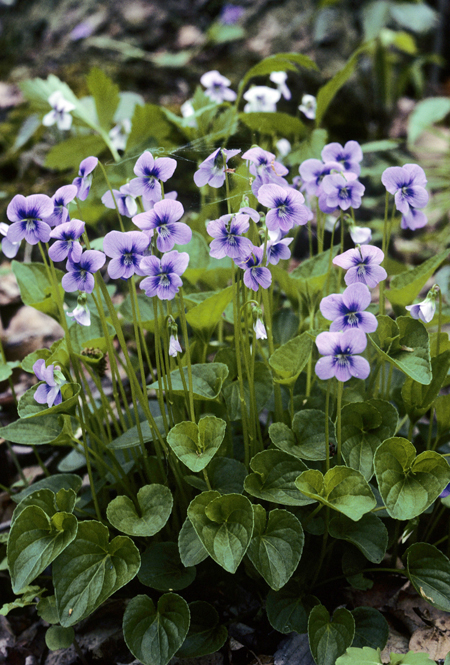
Leaves during chasmogamous flower by Bruce Sorrie
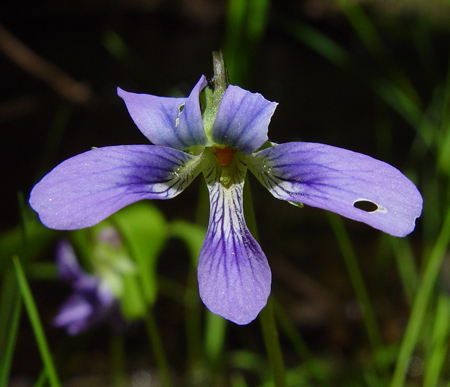
Chasmogamous flower front view (microtitis form) by Arthur Haines, Native Plant Trust
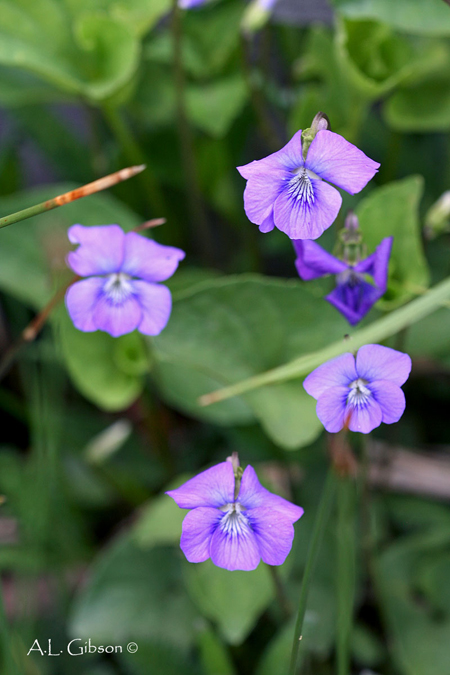
Chasmogamous flower front view Andrew Gibson, "Buckeye Botanist" website
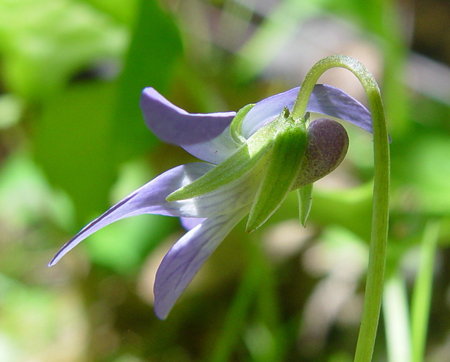
Chasmogamous flower profile view (microtitis form) by Arthur Haines, Native Plant Trust

Cleistogamous fruit by Harvey Ballard
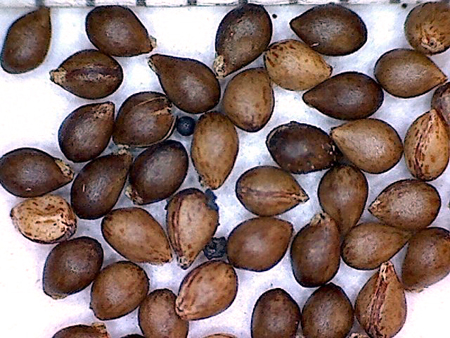
Seeds from herbarium specimen: CT, 5 Jul 1926, Beals & Chamberlain s.n. (NY)
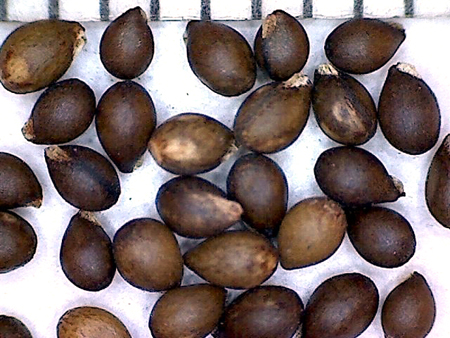
Seeds from herbarium specimen: Transplanted from NC, E. Brainerd 33 (NY)
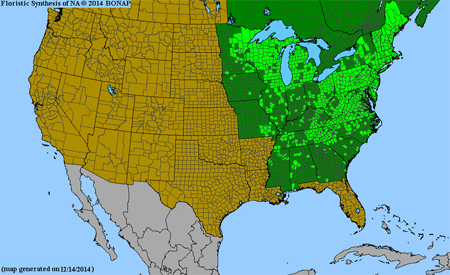
Map by Biota of North America Program